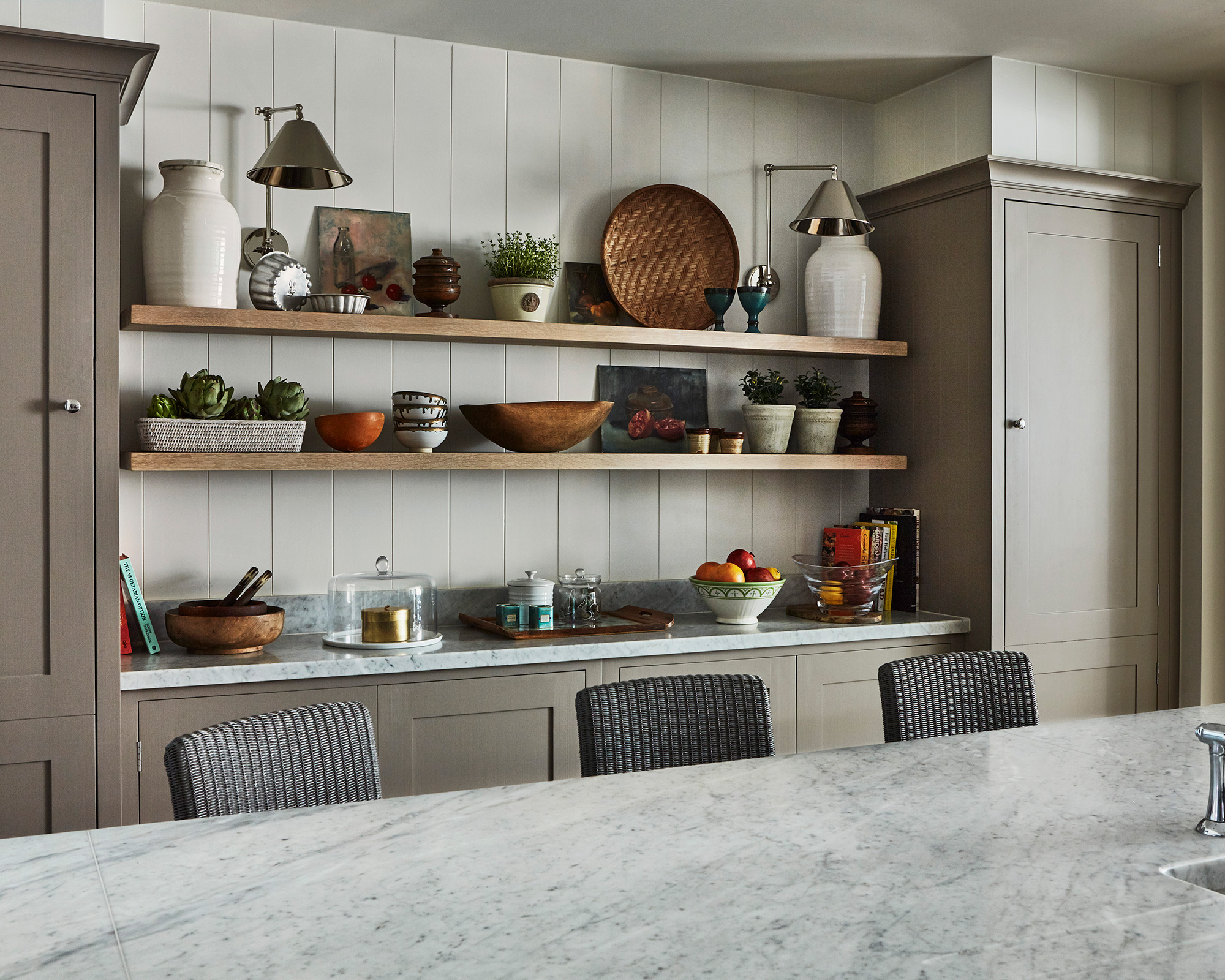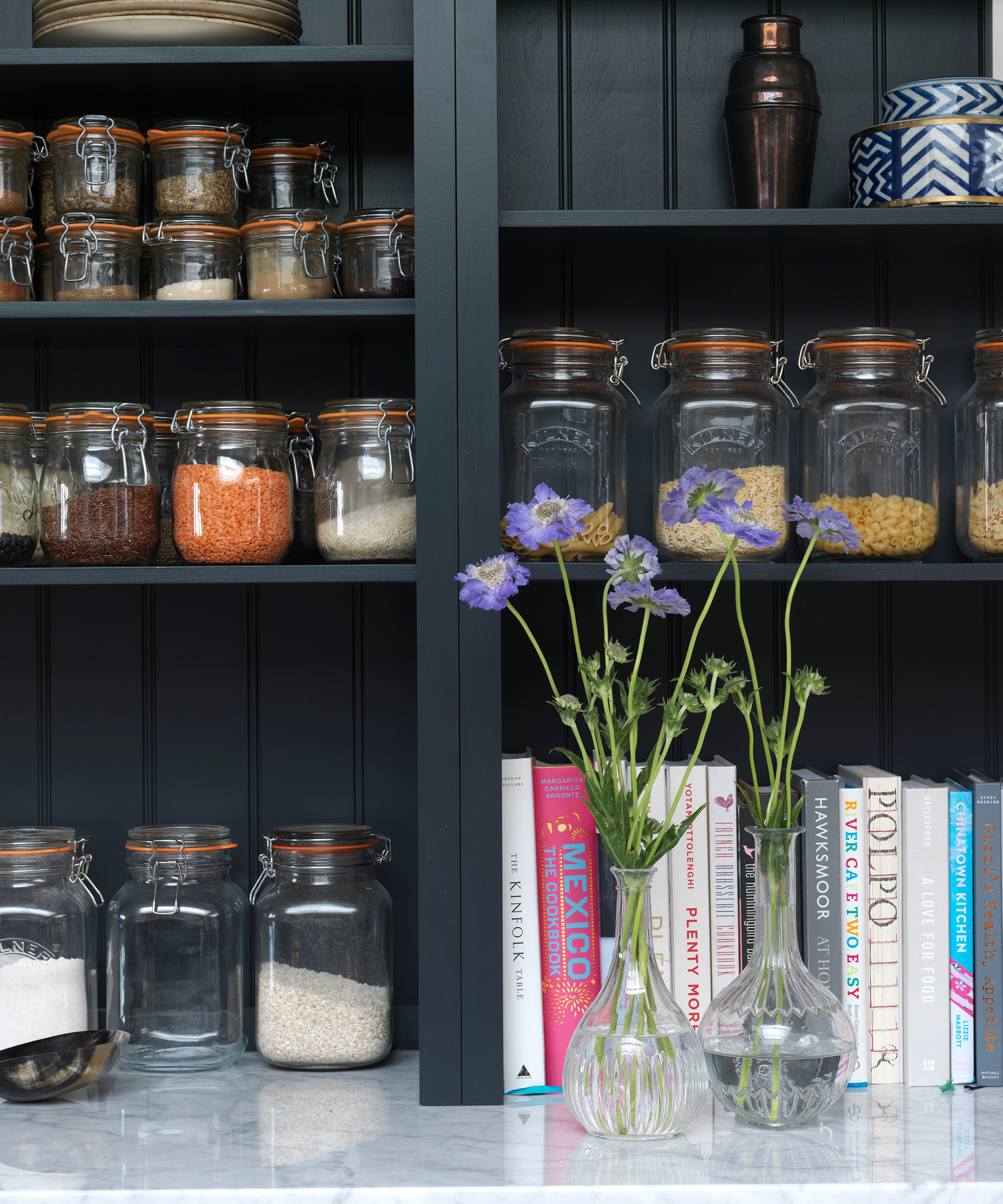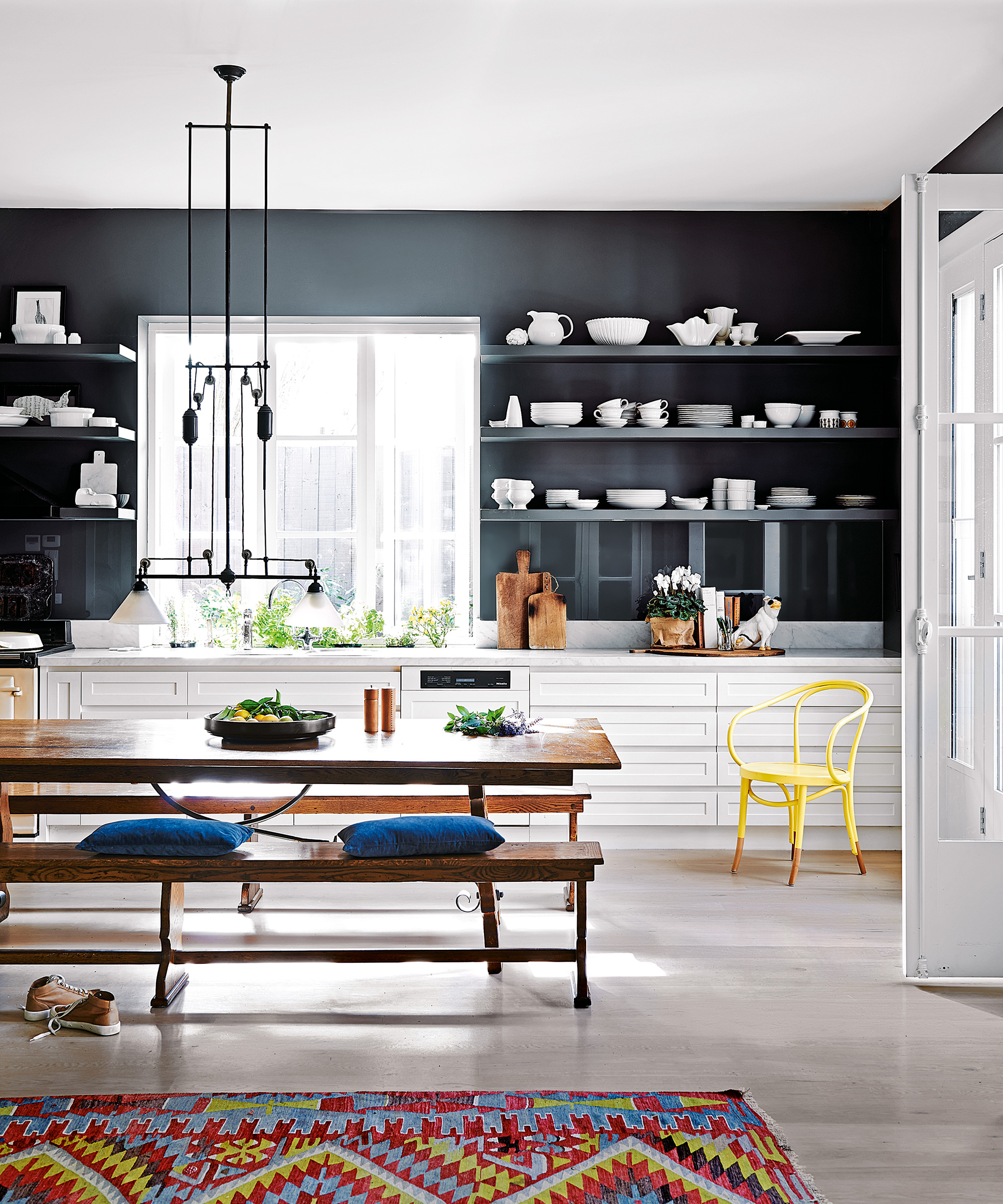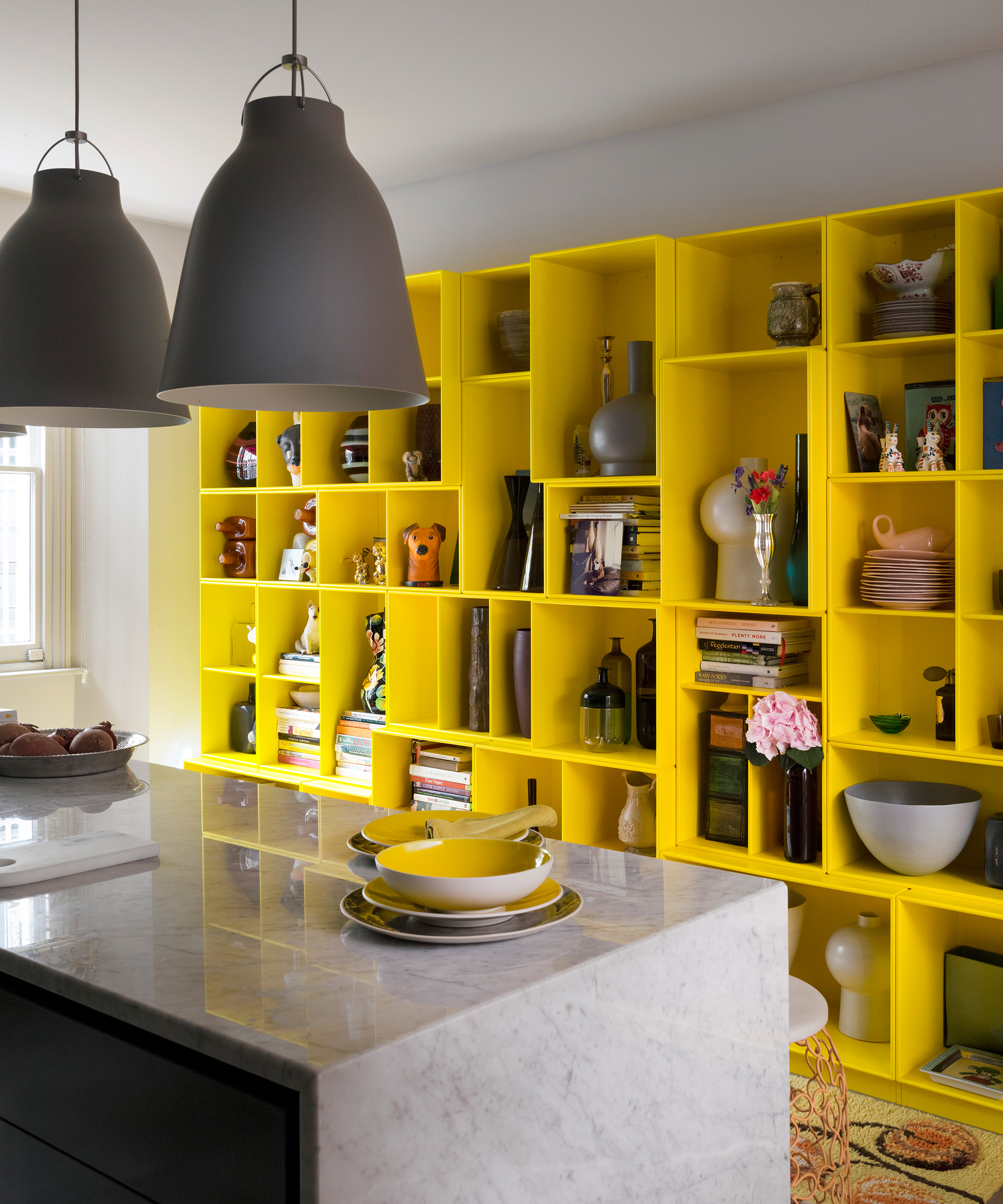
- 1. Organize your shelves based on which kitchen zone they’re in
- 2. Prioritize the things you use everyday…
- 3. …or those you never use
- 4. Incorporate items that are pretty, as well as practical
- 5. Be mindful of how you arrange things
- 6. Use stylish storage to conceal clutter
- 7. Add a potted plant or two
- FAQs
As well as providing practical storage, kitchen shelves offer up the opportunity to introduce a real sense of style into your cooking space, assuming you organize them properly, that is. Get it wrong, and you’ll achieve the complete opposite.
Luckily, knowing how to organize kitchen shelves like a designer should give you the confidence – and the ability – to get it right every time.
It’s true that practicality tends to take priority when it comes to kitchen shelving ideas, but that’s not to say they can’t look good. In fact, when organized to a high standard, designer-level standard, we should say, they can look positively great. Not to mention maximize on your kitchen storage ideas, too.
How to organize kitchen shelves like a designer
As any designer will tell you, decorating shelves successfully is all about achieving the perfect balance between practicality and style, so you’ll need to organize yours with everyday living in mind, whether that’s having plates and placemats located together for convenience, or mugs stacked neatly on the shelf above the kettle.
Doing this, along with the tricks we’ve suggested below, will result in neat, stylish and orderly kitchen shelves that you – and any designer – should be proud of.

1. Organize your shelves based on which kitchen zone they’re in
Good styling is aligned with function, so you’ll need to consider the positioning of your kitchen shelves. If they’re above a main workstation, it’s important you take its purpose into account,' says interior designer Jenny Kozena.
For example, a shelf near the hob might be used for organizing pots and pans or organizing spices, while those set above a countertop or within a kitchen island could play host to crockery and cookery books. Our guide to the six key zones of kitchen organizing should give you a good idea of what’s best placed where to achieve the most streamlined cooking space.
Design expertise in your inbox – from inspiring decorating ideas and beautiful celebrity homes to practical gardening advice and shopping round-ups.

Jenny is an interior designer originally from the UK and currently residing in California. With extensive experience in both commercial and residential design, she has honed her skills in creating stunning and functional spaces. Her ethos centers on creating timeless pieces that reflect the context of each project.
2. Prioritize the things you use everyday…

However ‘stylishly’ you do it, shoving your entire crockery collection onto your kitchen shelves is going to result in a cluttered-looking display, and likely a breakage or two. Similarly, with spices, cookbooks, plates, and so on, the more items you have, the harder it is to organize effectively.
‘Make organization – and styling – easier by taking a more considered approach to what you’re storing on your kitchen shelves. Set aside a smaller selection of essentials that you use on a day-to-day basis and prioritize these. Be sure to bear aesthetics in mind, too; less "sightly" items (think chipped glasses, plastic kid’s plates, chunky appliances etc) should be stored behind closed doors, regardless of how often you use them’, says Jennifer Ebert, editor at Homes & Gardens online.

Jen is the editor of Homes & Gardens online. Before starting this position, she had completed various interior design courses at KLC Design School, as well as working across Ideal Home, LivingEtc, 25 Beautiful Homes and Country Homes & Interiors as an interiors writer.
3. …or those you never use

If you’re lucky enough to have kitchen storage aplenty, you can get away with styling a purely decorative shelf. Stuff you like to look at, but don’t often use (think cake stands, serving platters, vases etc.) are great candidates. ‘Try and avoid smaller, more fiddly pieces if you can – they’re a magnet for dirt and aren’t as easy to clean. This includes glassware, but if you insist on it, at least store them upside down so the insides don’t get dusty,' says Millie Hurst, Solved section editor, Homes & Gardens.

Millie Hurst is Section Editor at Homes & Gardens, overseeing the Solved section, which provides readers with practical advice for their homes. Millie has written about and tried out countless cleaning and DIY hacks in the six years since she became a journalist, and has worked in both London and New York.
4. Incorporate items that are pretty, as well as practical

As much as it’s practical, kitchen shelving arrangements that are based solely around function can look a little stark. You’ll want to inject some personality, it is your home, after all. According to Houston-based interior designer Marie Flanigan, the trick is to choose items that fit the room’s aesthetic and position them with ease of access in mind.
‘On lower shelves, I opt for simple white plates, bowls, and mugs, coupled with cookbooks or kitchen accessories for easy access. As we move up the shelving unit, I’ll incorporate additional styling and serving pieces like bowls filled with fruit, pitchers, and cutting boards. On some of the higher shelves, I’ll choose more styling pieces like a small house plant, copper pots, or ceramics that add gorgeous texture, but aren’t necessarily items that will be used often,' she explains.
5. Be mindful of how you arrange things

When organizing surfaces of any kind, grouping items in odd numbers is more visually appealing than even numbers. Groups of three and five positioned symmetrically tend to work best. Millie advises arranging them by height in a triangle formation, ‘one taller item flanked by two smaller items’, and using a mix of textures and materials.
‘We often recommend pairing a large linear item like a cutting board with a horizontal item, such as a few stacked cookbooks. Then introduce a couple of sculptural items, such as a bowl of lemons or salt and pepper mills. Voila! Useful, organized and so pretty,' adds Heather Goerzen, design editor at Havenly.
Using shelf risers is another way to add depth and height to your display; choose a design that’s attractive to look at, or opt for clear acrylic versions like these, at Amazon.
6. Use stylish storage to conceal clutter

If you’re clever about it, open shelving can play host to kitchen items you actually don’t want on show (although these are the items never to store on kitchen shelves). Lining them with good-looking kitchen storage ideas offers up space for stashing cutlery, utensils, tea towels, table linens, even ingredients, which in turn frees up space in drawers and cabinets for bulkier items.
‘While transparent jars are a practical choice for stashing ingredients (as you can see when supplies are running low), stylish storage baskets are great for concealing clutter – similarly when organizing pantry shelves. Natural finishes, such as rattan or wicker blend in nicely with any scheme – I love these seagrass versions, at Wayfair. If you’ve got the depth, stackable designs make great use of vertical space and allow you to separate items by category inside, too. Attach hooks to the bottom of the shelves to hang pretty mugs for a nice finishing touch,' says Millie.
7. Add a potted plant or two
‘The presence of living greenery can evoke a sense of calm and connection with nature, which makes your kitchen feel more inviting,' says Jenny. Opt for potted plants that also serve a practical function, such as rosemary, thyme, and other herbs you like to use when cooking – not only will these be fragrant, but they’ll also inject a bit of color and interest into your display.
FAQs
What should I display on my kitchen shelves?
According to the experts, the best kitchen shelving ideas are those that look stylish without compromising on practicality, so you’ll need to bear both in mind when choosing what to display. Consider how you use your kitchen day-to-day and set aside those items you require regular access to – be sure to forgo anything that doesn’t bring you joy to look at (think chipped crockery, ugly appliances, and tattered old cookbooks, for example), you can store these behind closed doors, as part of organizing kitchen cabinets, instead.
‘While I’m all for pragmatic kitchen organization, it’s more than worth it to invest in and display everyday items that not only get the job done but look beautiful while doing it. Good examples include a marble pestle and mortar, vintage-inspired salt and pepper grinders, richly grained wooden cutting boards, a ceramic garlic stash, woven baskets for storing produce and a crafted wooden dish scrub’, says Heather.
That’s not to say every item has to be practical; potted plants, vases, cake stands, even children’s artwork can add personality to your shelving display. Ideally, you’d position these items perhaps a bit higher up, freeing up accessible storage for those items you access often.
Unlike the clutter we hide behind closed doors, kitchen shelving requires a little more thought if you want it to stay stylish – and well organized, of course. Taking tips from the designers is a good place to start, but don’t feel beholden to their advice; it’s what suits you and your lifestyle at the end of the day, so don’t be afraid to change things up every once in a while.

For 10 years, Tara King worked as a Content Editor in the magazine industry, before leaving to become freelance, covering interior design, wellbeing, craft and homemaking. As well as writing for Ideal Home, Style at Home, Country Homes & Interiors, Tara’s keen eye for styling combined with a passion for creating a happy – and functional – family home has led to a series of organization and cleaning features for H&G.
